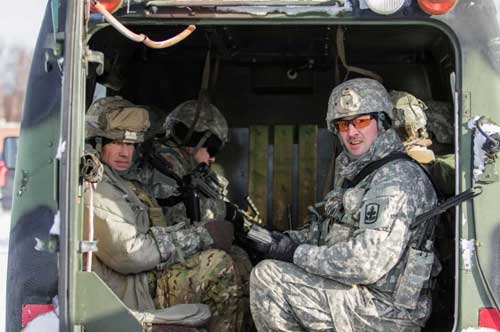RED DOG MINE PORTSITE, Alaska – The Coast Guard, industry resources and the Alaska National Guard successfully tested the emergency towing system three miles offshore of the Red Dog Mine Portsite in the Chuckchi Sea 83 miles north of Kotzebue Tuesday.
“This was a successful exercise for all involved and we owe a huge debt of gratitude to the Red Dog Mine and FOSS, without their resources and professionalism we would not have accomplished this effort,” said Lt. Cmdr. Maeve Keogh, District Seventeen response management. “The mine put us up and made their equipment available to us and when the Air National Guard helicopter crew had to abort the FOSS tug stepped in to transport the ETS before towing the SPAR.”
The exercise was originally designed to use an Air National Guard helicopter to transport the ETS from the portsite to the 225-foot Kodiak-based Coast Guard Cutter SPAR. The aircrew arrived Tuesday morning but on further inspection of the ETS, it’s sling-load net and the available space aboard the SPAR for the ETS to be dropped the ANG pilots chose to abort their portion of the training exercise for safety.
“The aircrew was more than willing to assist us but once they had a chance to compare their equipment and procedures to that of the Coast Guard’s they determined that it was not advisable for them to proceed due to safety,” said Keogh. “We do anticipate more joint work with them in the future and one-on-one familiarization with our gear and there’s. It was a good learning opportunity for all of us and we know where to go from here to make it work in the future.”
With in 30 minutes of the tug’s arrival the SPAR crew had readied the ETS and deployed the messenger line, which was picked up by the crew of the 126-foot Seattle-based Sidney Foss. The tug crew hauled the messenger and the thimble-end of the towing hawser aboard the tug and had the SPAR in tow making about 7 mph 10 minutes later. The whole exercise took about two hours to conduct.
The emergency towing system consists of a towing hawser made from synthetic line that floats with thimble attachment, chafing gear, shackle, messenger line, buoys and sea drogue and can be deployed to a disabled vessel by helicopter sling-load or hoisted aboard from a tug or other vessel of opportunity. The majority of the systems are designed to tow a vessel 50,000 dwt or larger. One system, purchased by the city of Unlaska and stationed at the port of Dutch Harbor, is used for 50,000 dwt or less.
The ETS was used successfully to tow the 738-foot cargo vessel Golden Seas when they lost propulsion in the North Pacific December 2010. The tug Tor Viking II, a vessel of opportunity in the region at the time, conducted the tow delivering the vessel safety to Dutch Harbor for repairs.
The ETS was developed as a tool to assist responders in Alaska following the grounding of the 738-foot cargo vessel Selendang Ayu December 2004 near Unalaska. Several assets had attempted to tow the ship and prevent it from grounding but the proper towing gear was not available and the line used snapped. The Department of Environmental Conservation, Coast Guard, City of Unalaska and the industry successfully tested the ETS in Dutch Harbor summer 2007. There are currently five ETSs, purchased by the Alaska Department of Environmental Conservation, stationed around Alaska with more planned for the future.






